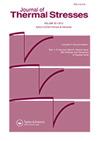Plane wave reflection in micropolar hygro-thermoelastic half-space
IF 2.6
3区 工程技术
Q2 MECHANICS
引用次数: 0
Abstract
AbstractThe research problem aims to investigate the effect of heat and moisture on the propagation of plane waves in a micropolar hygro-thermoelastic medium. The governing equations of a hygro-thermoelastic micropolar medium are developed and solved to determine the velocity equation. The plane-wave solution reveals that the medium is propagated by two coupled transverse displacement waves, namely Coupled Transverse Micropolar wave (CTM-wave) and Coupled Transverse Displacement wave (CTD-wave). Additionally, three coupled longitudinal waves are observed: thermal diffusion TD-wave, longitudinal displacement P-wave, and moisture diffusion mD-wave. To assess the characteristics of these waves in the micropolar hygrothermal medium, the speed and distance of propagation are calculated for each wave type. This analysis provides information on how fast and how far the P-wave, TD-wave, mD-wave, CTM-wave, and CTD-wave can travel in the medium. Furthermore, the research problem determines the equations for the coefficient of reflection and energy ratio when a coupled plane wave is incident on the medium. These coefficients quantify the amount of reflected energy compared to the incident energy and provide insights into the wave behavior at the interface of the medium. Finally, the variations in energy ratio and reflection coefficient are depicted graphically, allowing for a visual representation of how these quantities change with different parameters or conditions. These graphs provide a comprehensive understanding of the wave behavior and the effects of heat and moisture on the propagation characteristics in the micropolar hygrothermal medium.Keywords: Energy ratiohygrothermalmicropolar elasticityplane wavereflection coefficientspeed Disclosure statementNo potential conflict of interest was reported by the author(s).微极湿热弹性半空间中的平面波反射
摘要本研究问题旨在探讨热、湿对平面波在微极湿热弹性介质中传播的影响。建立并求解了湿热弹性微极介质的控制方程,确定了速度方程。平面波解表明介质是由两个耦合的横向位移波传播的,即耦合横向微极波(ctm波)和耦合横向位移波(ctd波)。此外,还观察到3种耦合纵波:热扩散td波、纵向位移p波和水分扩散md波。为了评估这些波在微极湿热介质中的特性,计算了每种波的传播速度和距离。该分析提供了纵波、td波、md波、ctm波和ctd波在介质中传播的速度和距离的信息。此外,研究问题还确定了耦合平面波入射介质时反射系数和能量比的计算公式。这些系数量化了与入射能量相比的反射能量,并提供了对介质界面波行为的深入了解。最后,用图形描述能量比和反射系数的变化,从而可以直观地表示这些量随不同参数或条件的变化。这些图提供了对波的行为和热湿对微极湿热介质中传播特性的影响的全面理解。关键词:能量比湿热微极性弹性平面波反射系数速度披露声明作者未报告潜在的利益冲突。
本文章由计算机程序翻译,如有差异,请以英文原文为准。
求助全文
约1分钟内获得全文
求助全文
来源期刊

Journal of Thermal Stresses
工程技术-力学
CiteScore
5.20
自引率
7.10%
发文量
58
审稿时长
3 months
期刊介绍:
The first international journal devoted exclusively to the subject, Journal of Thermal Stresses publishes refereed articles on the theoretical and industrial applications of thermal stresses. Intended as a forum for those engaged in analytic as well as experimental research, this monthly journal includes papers on mathematical and practical applications. Emphasis is placed on new developments in thermoelasticity, thermoplasticity, and theory and applications of thermal stresses. Papers on experimental methods and on numerical methods, including finite element methods, are also published.
 求助内容:
求助内容: 应助结果提醒方式:
应助结果提醒方式:


